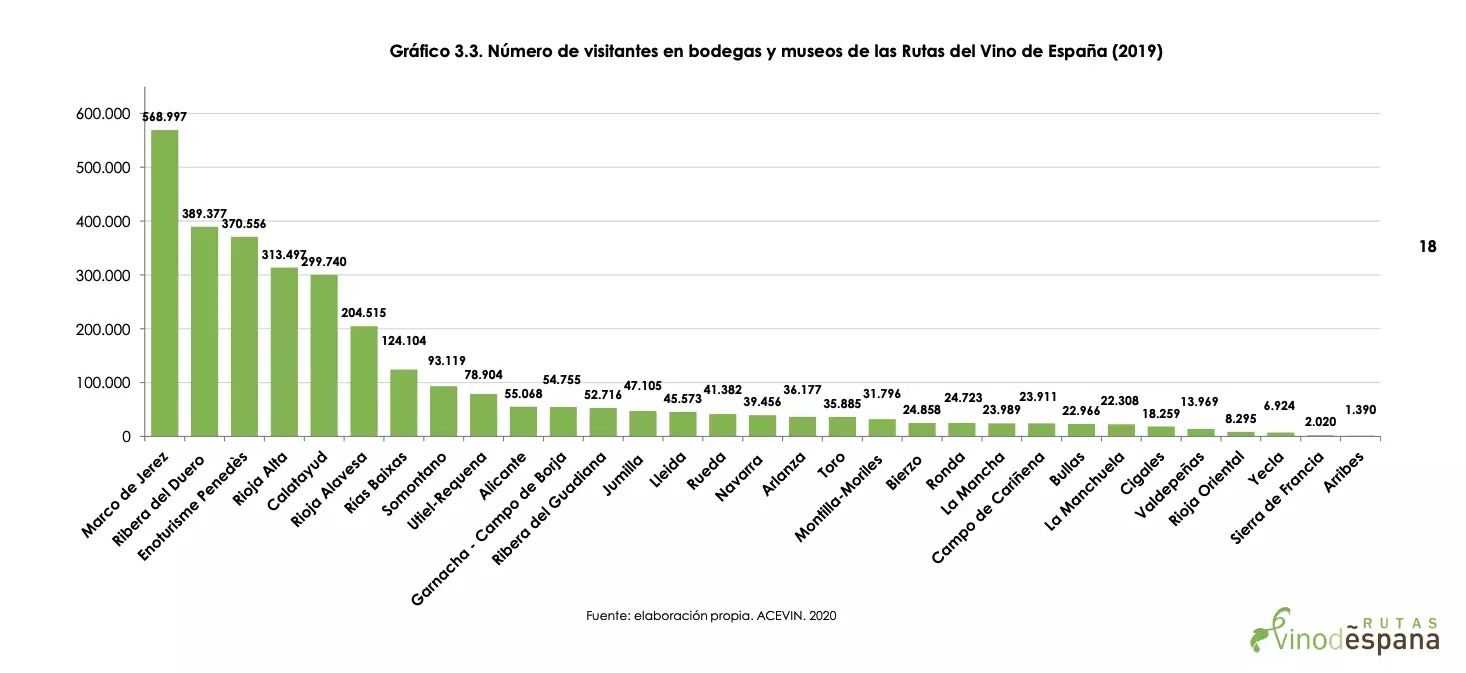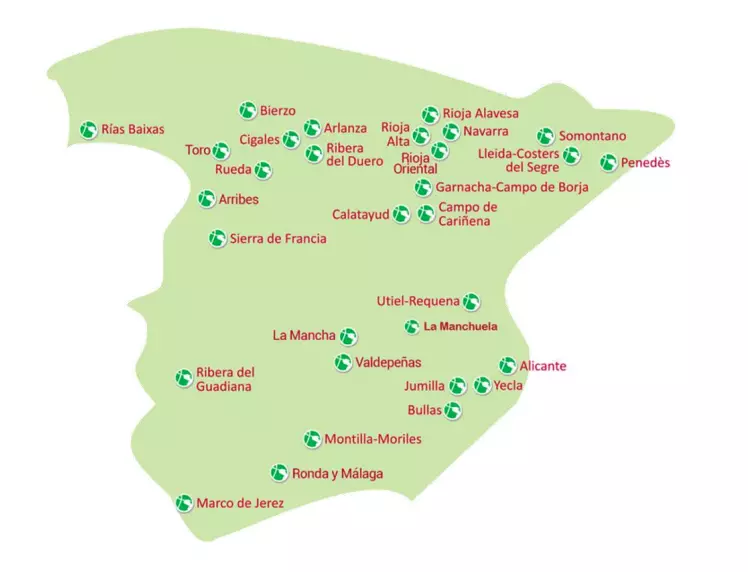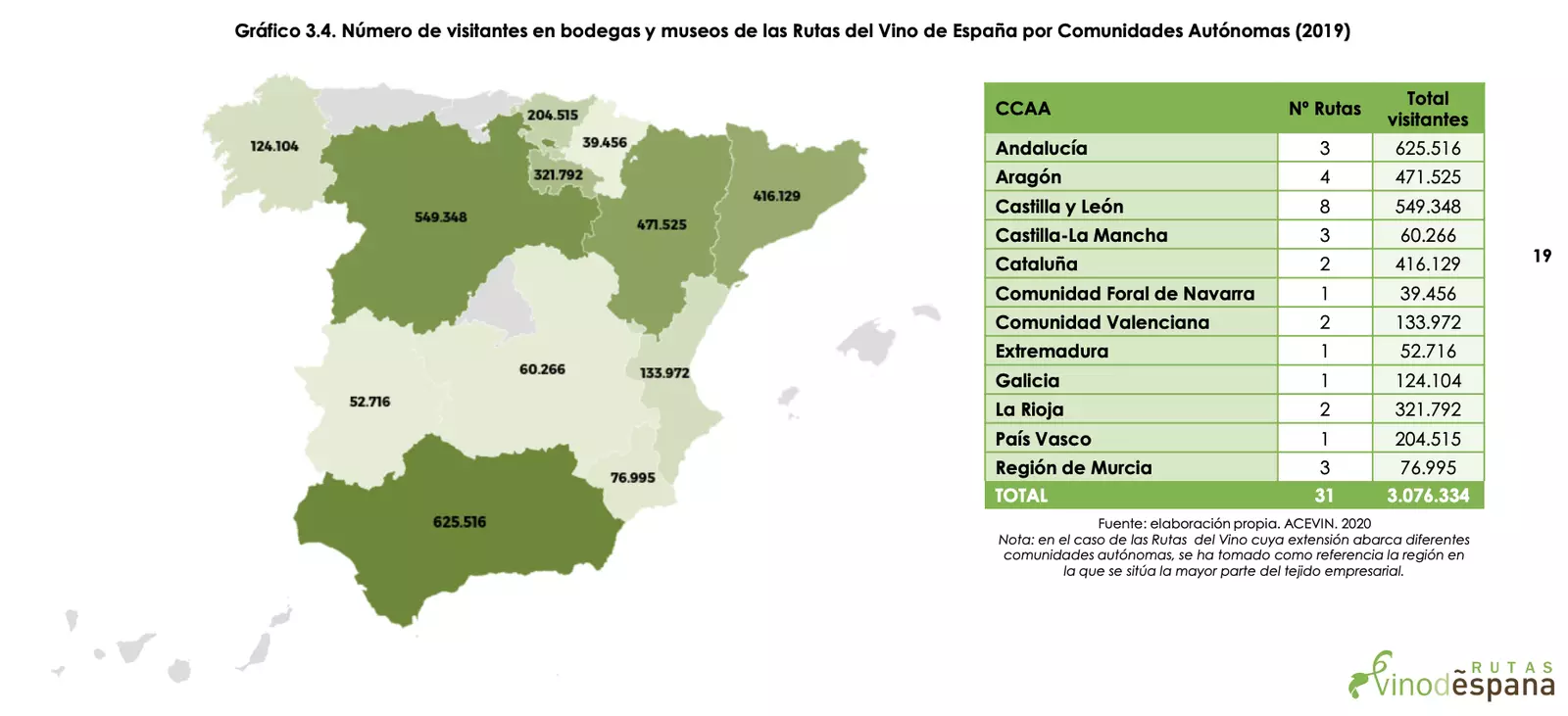
The most visited wine routes in Spain
Wine tourism in Spain continues to offer positive data in terms of growth not only in the offer and the number of visitors, but also in the magnitudes that approximate its economic impact.
This follows from the twelfth Annual Report on Visits to Wine Cellars and Museums associated with the Wine Routes of Spain, prepared by the Tourist Observatory of the Spanish Association of Wine Cities (ACEVIN).
This report collects data on wine tourism in our country during the year 2019 and it states an increase of 3.9% in visitors during the year 2019.
The Marco de Jerez Wine and Brandy Route, the Ribera del Duero Wine Route and Enoturisme Penedès were the three most visited routes in 2019.

Number of visitors to wineries and museums on the Spanish Wine Routes (2019)
ECONOMIC IMPACT OF SPANISH WINE ROUTES
The range of wine tourism services linked to the Spanish Wine Routes has experienced a significant growth during 2019, according to the report.
The main reasons for this growth are: the incorporation of new routes –Toro, Valdepeñas and La Manchuela– and the positive evolution of the existing ones.
In total, the set of Wine Routes of Spain has received 3,076,334 visitors to its wineries and museums last year, 3.88% more than in 2018.
The volume of business derived from visits to wineries and museums that are part of the Spanish Wine Routes presents an increase of almost 6% compared to the previous year, exceeding 85 million euros.

The 31 Wine Routes of the Wine Routes of Spain Product Club
VISITS TO WINERIES AND MUSEUMS INCREASE
Faced with the decrease in visits in 2018 -due to the exit of the group routes such as Txakoli and Empordà-, the number of visits in 2019 increased by 3.9% compared to the previous year, exceeding 3 million wine tourists.
On the whole of the Spanish Wine Routes, an average of 25.3% of international visitors compared to 74.7% of national visitors.
And as for the months of greatest growth, the increase in wine tourists received during the months of April and May 2019 stands out, although the month with the highest influx is still October (335,453 visitors), followed by August and September.
The report also notes that the average price of the visit increased to 10.12 euros, the same as visitor spending, which rose to 20.68 euros on average.
In museums, however, the average expenditure fell slightly from 7.24 euros to 7.19 euros. However, in most cases, the average expenditure per visitor is higher than the price of the visit, which indicates that tourists spend more on the purchase of wine and other products offered in wineries and museums than on the visit itself.

Evolution of the number of visitors (2008-2019)
THE MOST VISITED WINE ROUTES
The Spanish Wine Routes Product Club has 31 members who present very different tourist realities due to various factors such as the size of the wine tourism offer of its wineries, the location, the tourist development of the destinations, etc.
The above assumes that there significant differences in the number of visitors received on each route. Of course, the report confirms that practically all the Wine Routes in Spain have experienced a increase in visitors.
The first place in the 2019 visits ranking goes to the Marco de Jerez Wine and Brandy Routes (568,997 visitors), position that it already held the previous year.
They are followed, in second position, the Ribera del Duero Wine Route (389,377 visitors) and in third position, the Penedès Wine and Cava Route Enoturisme Penedès (370,556 visitors).

Number of visitors to wineries and museums by Autonomous Community (2019)
The next places on the list, with routes exceeding 100,000 visitors, are for: Rioja Alta (3,131,497 visitors), Calatayud (299,740 visitors), Rioja Alavesa (204,515 visitors) and Rías Baixas (124,104 visitors).
Likewise, the report highlights the important increases, in relative terms, with respect to the previous year, of the Navarra Wine Routes (54.10%), Rioja Oriental (40.69%), Sierra de Francia (36.58%), Montilla-Moriles (29.71%) and Cigales (26.53%).
The routes that received a higher proportion of international visitors were the Ronda Wine Routes (54.1%), Enoturisme Penedès (51.8%), Alicante (50.6%), Yecla (46.1%) and Marco de Jerez (42.3%).
We must point out that the data in the report only corresponds to activities related to visits to wineries and museums and the expenditure made in the stores of these establishments.
That is, they do not include other concepts or services offered by wineries and museums and that also generate significant economic activity (such as rental of spaces, special tastings, commercial presentations, etc.).
Data related to other agents and services that are part of the Wine Routes, such as accommodation, restaurants, shops or activity companies.
If this wide diversity of companies involved were taken into account, It is estimated that the total turnover generated by wine tourism on the Spanish Wine Routes would reach 256.7 million euros.
2020: AN IMPORTANT CHALLENGE
This new edition of the Annual Report on Visits to Wineries and Wine Museums associated with the Spanish Wine Routes also pays attention to the challenges facing the future of wine tourism, a sector with a marked seasonal effect, that contributes to territorial balance and complements other segments such as rural, cultural and sun and beach tourism.
Thus, the next report for 2020 will present data that will reflect the COVID-19 health crisis and given this, ACEVIN and Rutas del Vino de España are committed to highlighting "the differential attributes of this tourist product as key elements for the reactivation of the sector and as elements of attraction of a vacation option especially fed by the national market: authenticity, scarcely crowded destinations, immersion in the rural environment and in nature, slow tourism and gastronomy”.
ACEVIN has also prepared the ‘Guide to reactivate post-COVID wine tourism’ , which was born with the purpose of being a useful ally for both the Routes and the companies in the sector, when it comes to practicing safe and responsible tourism.
